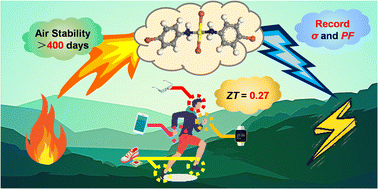Giant power factor and high air stability in an n-type metal–organic charge-transfer complex†
Abstract
The biggest bottleneck delaying the practical applications of organic thermoelectric devices is the lack of high-performance n-type semiconductors with high air stability. Herein, we report an n-type metal–organic coordination complex (Br–C6H4–NH2)2CuBr2. This material exhibits an exceptionally high room-temperature electrical conductivity of >3990 S cm−1, leading to a giant power factor of >1589 μW m−1 K−2, which is the highest value for organic thermoelectric materials. Besides, the (Br–C6H4–NH2)2CuBr2 film retained 87.8 per cent of the original electrical conductivity after being stored in air for 109 days, which is a record-breaking value for an n-type organic TE material. More surprisingly, we find that this substance does not decompose even after immersion in pure water for 405 days. We demonstrate that the giant power factor mainly arises from an ultrahigh electrical conductivity, which mainly comes from the efficient electron transfer from Br–C6H4–NH2 to CuBr2. This work opens a new era for solving the long-standing key challenges of achieving air-stable and high-performance n-type organic thermoelectric materials.



 Please wait while we load your content...
Please wait while we load your content...